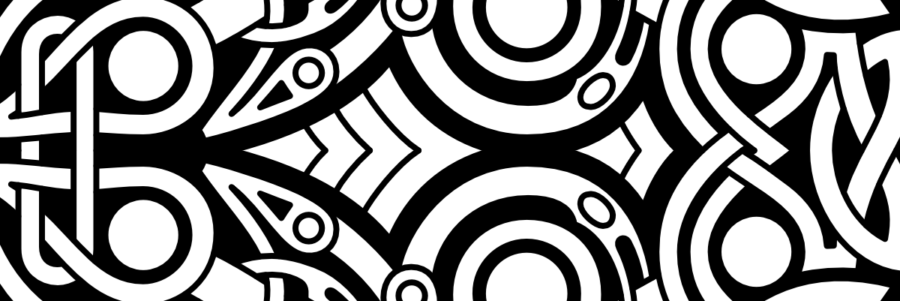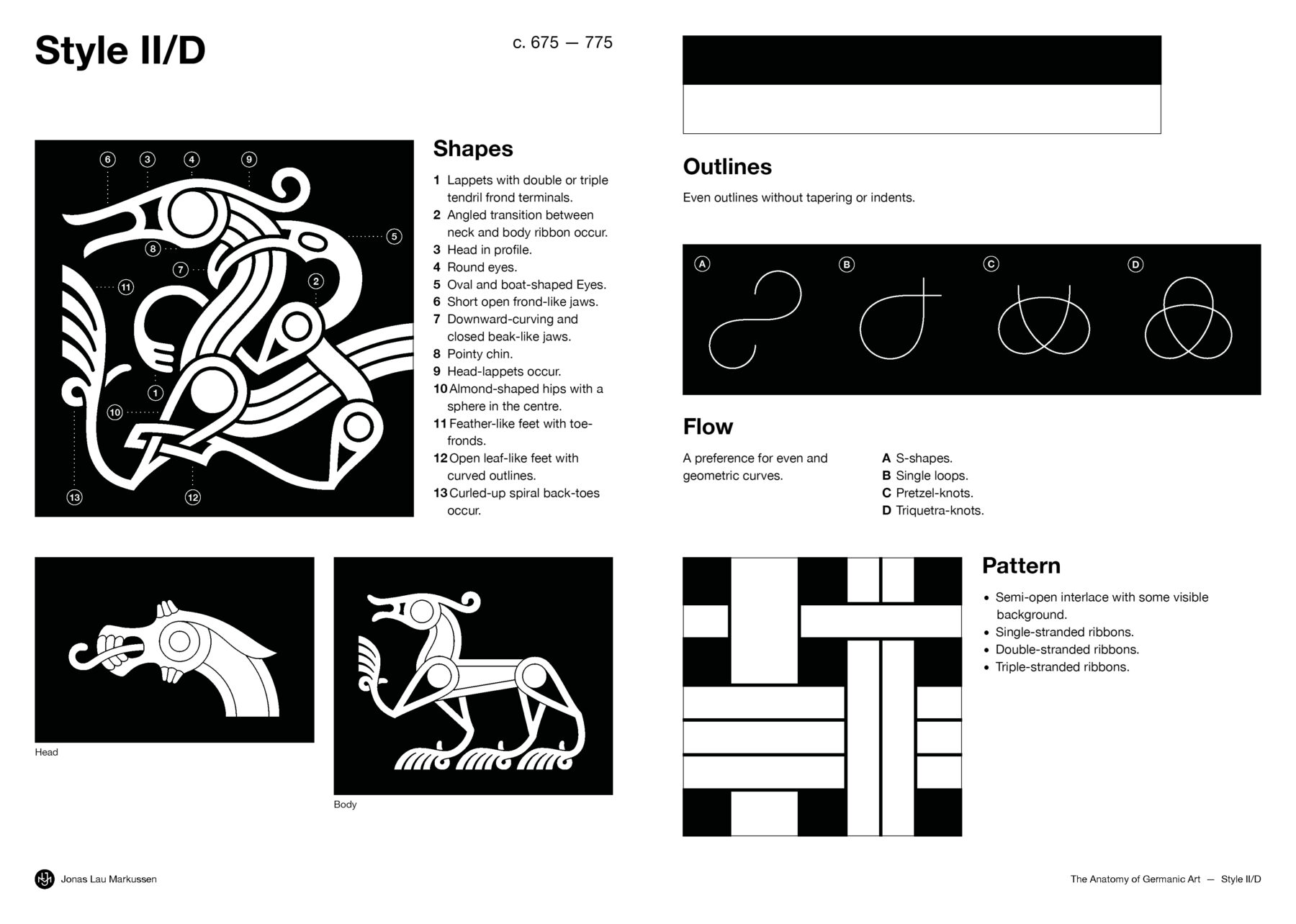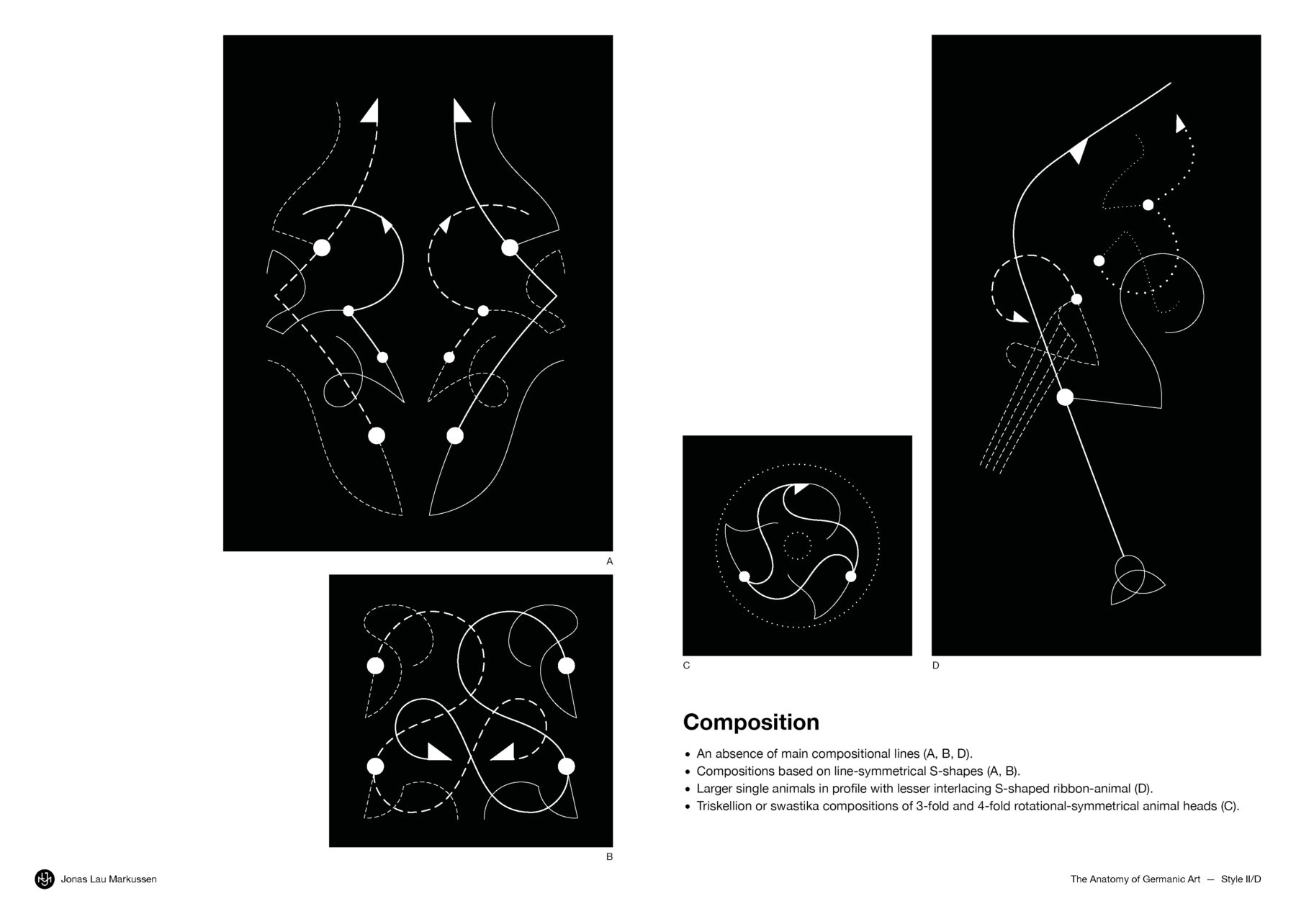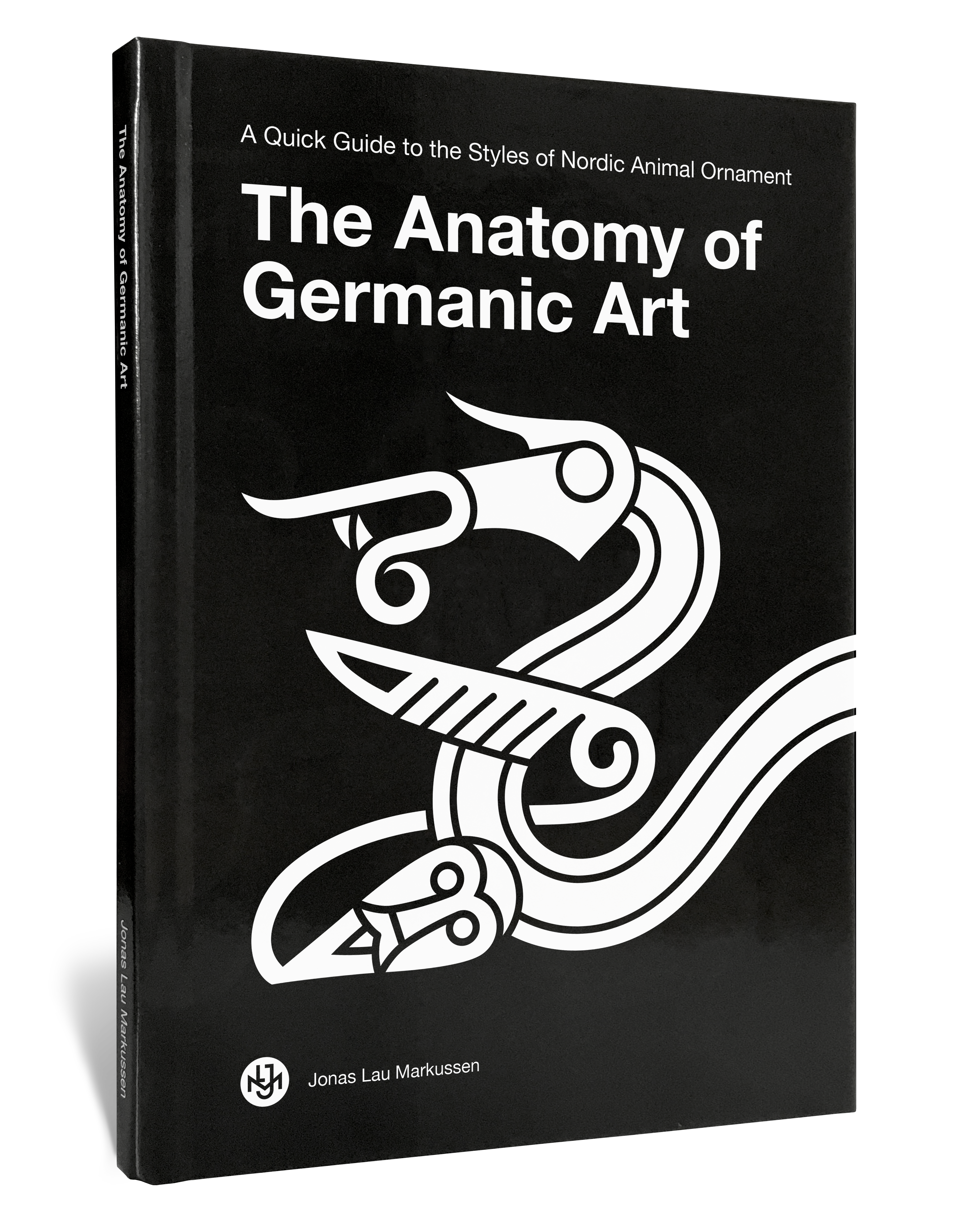
Style II/D
July 18, 2018
The Anatomy of Germanic Art
- Introduction
- Early Animal Style
- Style I
- Style II/B
- Style II/C
- Style II/D
The Anatomy of Style II/D
c. 675 – 775
Shapes
1. Lappets with double or triple tendril frond terminals.
2. Angled transition between neck and body ribbon occur.
3. Head in profile.
4. Round eyes.
5. Oval and boat-shaped Eyes.
6. Short open frond-like jaws.
7. Downward-curving and closed beak-like jaws.
8. Pointy chin.
9. Head-lappets occur.
10. Almond-shaped hips with a sphere in the centre.
11. Feather-like feet with toe-fronds.
12. Open leaf-like feet with curved outlines.
13. Curled-up spiral back-toes occur.
Outlines
Even outlines without tapering or indents.
Flow
A preference for even and geometric curves.
A. S-shapes.
B. Single loops.
C. Pretzel-knots.
D. Triquetra-knots.
Pattern
- Semi-open interlace with some visible background.
- Single-stranded ribbons.
- Double-stranded ribbons.
- Triple-stranded ribbons.
Composition
- An absence of main compositional lines (A, B, D).
- Compositions based on line-symmetrical S-shapes (A, B).
- Larger single animals in profile with lesser interlacing S-shaped ribbon-animal (D).
- Triskellion or swastika compositions of 3-fold and 4-fold rotational-symmetrical animal heads (C).
Motifs
- S-shaped ribbon animals (A, B, D).
- Four-legged animals (A, B, C, D).
- Birds of prey (D).
Expansion of Empires
The Frankish Empire
Pepin the Short, son of Charles Martel, ushered in a new chapter for the Frankish Empire. His reign marked the rise of the Carolingian dynasty, which would later produce significant rulers like Charlemagne. Pepin expanded Frankish territorial boundaries, consolidated power and established a centralised authority, solidifying the empire’s position as a dominant force. Pepin’s successor, Charlemagne, launched a campaign against the Frisians east of the Lauwers River with a formidable army. Through several battles, Charlemagne defeated the Frisians, effectively ending their independence. This conquest expanded the Frankish Empire further eastward, setting the stage for subsequent events, including the Saxon Wars.
The Danube Bulgaria
Danube Bulgaria arose as a powerful state along the Danube River in the east. Slavic tribes coalesced, forging alliances and establishing trade routes. Their cultural exchange with Constantinople and the Khazars enriched their civilisation. The Danube Bulgaria’s strategic location facilitated both commerce and military expansion.
The Caliphate
Across the Strait of Gibraltar, the Umayyad Caliphate launched its conquest of the Iberian Peninsula (modern-day Spain and Portugal). Their swift advance challenged the Visigothic kingdom, leading to the fall of Toledo and the establishment of Al-Andalus. The rich blend of Islamic, Christian, and Jewish cultures would flourish in this new realm. Córdoba became a centre of learning, architecture, and tolerance. The Abbasid Caliphate was established in 750 after overthrowing the Umayyad Caliphate during the Abbasid Revolution. Initially centred in Kufa, modern-day Iraq, the Abbasids later established Baghdad as their capital in 762.
Scandinavia
On the west coast of Jylland, Denmark, Ribe was established as an emporium in 705. This trading hub facilitated commerce and cultural exchange. By 725, coins were being minted at Ribe, reflecting its economic importance. On the other side of the Jylland peninsula, a significant fortified hall and possibly a temple was established at Erritsø in the 8th century. Situated on a headland overlooking a crucial junction at the narrow end of Lillebælt, the sound between Jylland and the island of Fyn, its strategic location made it a vital point for monitoring both maritime and land traffic. Ships arriving from the south and east-west land traffic to and from Fyn could be observed from this vantage point. The layout of this residence resembled other elite residences from the same period, such as those at Tissø and Lejre. Two ships equipped with sails, buried at Saaremaa in Estonia around 700, hint at the Scandinavian seafaring prowess. These ships are the earliest known Nordic vessels of their kind. Around 750, Scandinavian settlers established a presence in Ladoga. This settlement, situated along vital trade routes, was one of the first steps in Scandinavian expansion along the waterways through Eastern Europe, connecting Scandinavia to Constantinople. The Battle of Brávellir stands as a moment where sagas and history converge. Allegedly fought in the vicinity of Bråviken in Östergötland or Småland in c. 770, this clash pitted Sigurd Ring, King of the Västergötland, against Harald Hildetand, King of the Danes and the Geats of Östergötland according to the sagas. Although the battle’s historicity remains debated, its significance endures in Nordic sagas and poetry.
Abstraction of the Animal Bodies
Development
The animals in Style II/D are considerably more stylised than in Style II/C. The heads of the beasts are, for example, usually either significantly simplified or abstracted into geometric shapes. The mouth of a beast seen in front can be comprised of a triquetra knot, and the jaws of ribbon animals seen in profile are often joined at the end, rendering them beak-like, though they are without question not birds. There’s also a new sense of experimentation in the composition, opening up for a more loosely flowing interlacing style hinting at what’s to come in the often more lively and organic variation of animal ornamentation in the subsequent Broa style.
Animal-shaped Openwork Brooches
Openwork brooches in the shape of common predatory animals, such as birds of prey and four-legged beasts, which frequently seize and bite smaller, swirling serpent-like animals, are among the most stunning Style II/D examples.
Oval Animal-shaped Brooches
The style’s most distinctive manifestation and possibly its most intriguing object type are the oval animal-shaped brooches, distinguishing the style from its predecessor and successor. While the composition is still very much created by ribbon animals, the body of the main animal can be almost completely dissolved into ribbon ornamentation and very loosely held together. Its features are highly abstracted into geometric shapes and triquetra- and pretzel knots. Lesser ribbon animals weaving through the main animal body and its limbs are also highly stylised and care little about resembling organic animal anatomy.
Harness Mounts
The prestige horse tack in this style effectively illustrates the range of Style II/D. Rectangular mounts with rich ribbon-animal ornamentation, animal head-shaped strap-ends, and openwork animal-shaped or geometric pieces often come together to create a lavish horse harness.
Examples
Examples on Gelmir.com →
A list of examples with photos, info and links to sources.
Animal head-shaped bead spreader — Kunsta
Kunsta, Uppland, Sweden.
Historiska Museet, Stockholm, 108956.
Animal head-shaped bead spreader — Öland
Öland, Sweden.
Historiska Museet, Stockholm, 416101.
Animal head-shaped Harness Mount
Stjørdal, Nord-Trøndelag, Norway.
Kulturhistorisk Museum, Oslo, C54762/1.
Animal-shaped brooches — Björkö
Björkö, Uppland, Sweden.
Historiska Museet, Stockholm, 106991.
Animal-shaped brooch — Engegård Nord
Engegård Nord, Bornholm, Denmark.
Nationalmuseet, København, C35692.
Animal-shaped brooch — Lousgaard
Lousgaard, Bornholm, Denmark.
Nationalmuseet, København, C5607.
Animal-shaped brooch — Söderby
Söderby, Åland, Finland.
Kansallismuseo, Helsinki, KM5197:2.
Animal-shaped brooch — Veggerslev
Veggerslev, Sjælland, Denmark.
Nationalmuseet, København, C6592.
Animal-shaped jewellery
Lousgaard, Bornholm, Denmark.
Nationalmuseet, København, C5709.
Animal-shaped mount
Ibestad, Troms, Norway.
Norges Arktiske Universitetsmuseum, Tromsø, Ts12569/1.
Bead spreader — Eke
Eke, Gotland, Sweden.
Historiska Museet, Stockholm, 274128.
Bird-and-man-shaped brooch — Øster Nordlunde
Øster Nordlunde, Lolland, Denmark.
Nationalmuseet, København, C43758.
Bird-shaped brooch — Bederslev
Bederslev, Fyn, Denmark.
Nationalmuseet, København, -.
Bird-shaped brooch — Denmark
Denmark.
Nationalmuseet, København, -.
Bird-shaped brooch — Ferkingstad
Ferkingstad, Rogaland, Norway.
Arkeologisk Museum Universitetet i Stavanger, Stavanger, S4260.
Bird-shaped brooch — Gjesval
Gjesval, Viken, Norway.
Kulturhistorisk Museum, Oslo, C58110.
Bird-shaped brooch — Jessnes Nedre
Jessnes Nedre, Innlandet, Norway.
Kulturhistorisk Museum, Oslo, C62609.
Box brooch
Salmunds, Gotland, Sweden.
Historiska Museet, Stockholm, 453348.
Brooch — Nørre Sandegård
Nørre Sandegård, Bornholm, Denmark.
Nationalmuseet, København, C31046.
Harness mounts — Vendel 108950
Vendel, Uppland, Sweden.
Historiska Museet, Stockholm, 108950.
Harness mounts — Vendel 273995; 3124593; 971469
Vendel, Uppland, Sweden.
Historiska Museet, Stockholm, 273995; 3124593; 971469.
Oval animal-shaped brooch — Brønnøy, T14049/III_a.012
Brønnøy, Nordland, Norway.
NTNU Vitenskapsmuseet, Trondheim, T14049/III_a.012.
Oval animal-shaped brooch — Brønnøy, T14049/III_a.013
Brønnøy, Nordland, Norway.
NTNU Vitenskapsmuseet, Trondheim, T14049/III_a.013.
Oval animal-shaped brooch — Brønnøy, T14049/III_a.014
Brønnøy, Nordland, Norway.
NTNU Vitenskapsmuseet, Trondheim, T14049/III_a.014.
Oval animal-shaped brooch — Kvarøen Ytre
Kvarøen Ytre, Nordland, Norway.
Norges Arktiske Universitetsmuseum, Tromsø, Ts6377/b.
Oval animal-shaped brooch — Utakleiv
Utakleiv, Nordland, Norway.
UiT Norges Arktiske Universitetsmuseum, Tromsø, Ts3497/b.
Oval animal-shaped brooch — Vandel
Vandel, Jylland, Denmark.
Nationalmuseet, København, C13494.
Rectangular brooch
Billingstad, Viken, Norway.
Kulturhistorisk Museum, Oslo, C29928.





